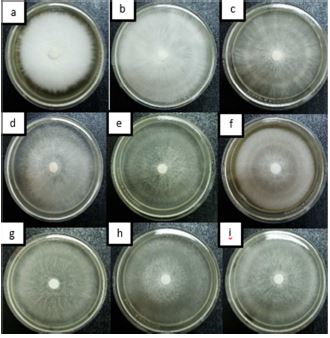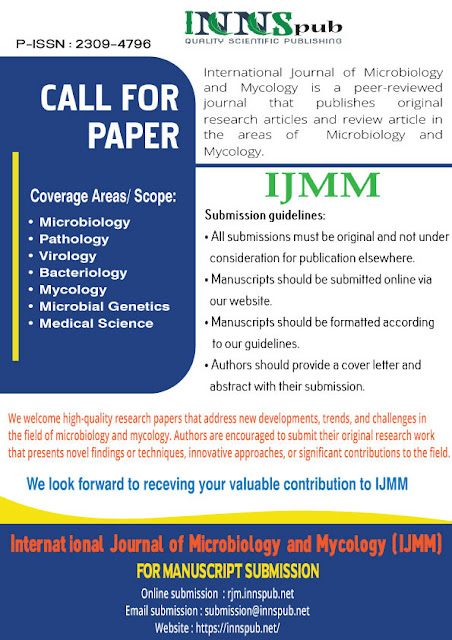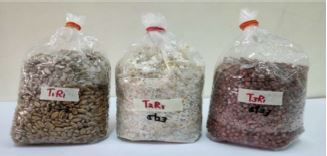E. Soriano, Veronica P.
Mangune, and Melody S. Pascua, from the different institute of the Philippines.
wrote a research article about, Low-Cost Cultivation Protocol for Ganoderma
lucidum. entitled, Development of low-cost cultivation protocol for Ganoderma
lucidum (Curtis) P. Karst. This research paper published by the International journal of Microbiology and Mycology (IJMM). an open access scholarly research
journal on Microbiology. under the affiliation of the International
Network For Natural Sciences | NNSpub. an open access
multidisciplinary research journal publisher.
Abstract
Ganoderma lucidum commonly known as lingzhi mushroom, or reishi mushroom in some countries, is an edible
mushroom known for its medicinal value. This study evaluated the optimum
culture media, grain spawn and substrate formulation for the cultivation
of G. lucidum. The use of different low-cost culture media, grains and
substrate formulations in the preparation of pure cultures, grain spawn bags
and fruiting bags of G. lucidum were tested. The largest mycelial
diameter was observed in Potato Sucrose Agar (93.45mm) which was significantly
higher among all the treatments used. It has very thick mycelial density.
Cracked corn as spawning material had the shortest incubation period of 14
days, which showed significant difference compared to sorghum seeds and barley
grains. The use of cracked corn also incurred the lowest cost and highest
return of investment in grain spawn bag production. For fruiting bag
production, substrate combination of 50% sawdust and 30% rice straw
supplemented with 20% rice bran was the best formulation for fruiting bag
production of G. lucidum which had the highest yield with a mean
value of 91.30g and biological efficiency of 20.29%.
Read more : Bidens pilosa Linn.Aqueous Extract against Postharvest Fungal Pathogens | InformativeBD
Introduction
Mushrooms are
considered ultimate healthy food and dietary supplements. They contain
proteins, carbohydrates, minerals, vitamins, saturated fatty acids, phenolic
compounds, tocopherols, ascorbic acid and carotenoids (Ho et al., 2020). Thus,
mushrooms can be used directly in the diet and promote health, taking advantage
of both the additive and synergistic effects of all bioactive compounds present
in it (Reis et al., 2011).
The cultivation of
edible mushrooms could become a way to augment farm income while making use of
crop-based residues. The growth of a variety of mushrooms requires different
type of substrates and availability of different type of materials. Substrates
such as logs, wood sawdust, rice straw and hull, banana leaves, maize stalk,
and various grasses can all support mushroom growth (Philippoussis, 2009). In
some parts of the Philippines, these substrates may not be available or are
available at relatively high prices. Thus, mushroom growers are continuously
searching for alternative substrates that may be more readily available or cost
effective, or that may provide higher yield and better mushroom quality (Royse
D et al., 2004).
With the need to
cultivate G. lucidum using lowcost inputs and locally available materials, this
project envisioned to determine the best culture media, grain and substrate in
terms of biological and cost efficiency. Discovering the best culture media,
grain and substrate for G. lucidum may lead to the development of mushroom
production technologies that may increase yield, and in effect further increase
farmers’ income.
Reference
Ho L, Zulkifli N, Tan
T. 2020. Edible mushroom: nutritional properties, potential nutraceutical
values, and its utilisation in food product development. An introduction
to mushroom 10
Reis F, Barros L,
Martins A, Ferreira I. 2011. Chemical composition and nutritional value of
the most widely appreciated cultivated mushrooms: an inter-species comparative
study. Food and Chemistry 128, 674-678
Philippoussis A. 2009.
Production of mushrooms using agro-industrial residues as substrates 10.1007/978-1-4020-9942-7_9
Royse D, Rhodes T, Ohga
S, Sanchez J. 2004. Yield, mushroom size and time to production of Pleurotus
cornucopiae (Oyster mushroom) grown on switch grass substrate spawned and
supplemented at various rates Bioresource Technology 91, 85-91
Yang F, Liau C. 1998.
Effect of cultivating conditions on the mycelial growth of Ganoderma
lucidum in submerged flask cultures Bioprocess Engineering 19, 233-236
Wagner R, Mitchell D,
Sassaki G, Amazonas M, Berovic M. 2003. Current techniques for the
cultivation of Ganoderma lucidum for the production of biomass,
ganoderic acid and polysaccharides Food Technol Biotechnol 41, 371-382
Azizi M, Tavana M,
Farsi M, Oroojalian F. 2012. Yield performance of lingzhi or reishi medicinal
mushroom, Ganoderma lucidum (W.Curt.:Fr.) P. Karst. (Higher
Basidiomycetes), using different waste materials as substrates International
Journal of Medicinal Mushrooms 14, 521-527
Wachtel-Galor S, Yuen
J, Buswell J, Benzie I. 2011. Herbal medicine: Biomolecular and clinical
aspects, 2nd ed. Boca Raton: CRC Press
Chang S, Buswell J. 2008.
Safety, quality control and regulational aspects relating to mushroom
nutriceuticals Proceedings of 6th International Conference in Mushroom Biology
and Mushroom Products. GAMU Gmbh, Krefeld, Germany
Boh B, Berovic M, Zhang
J, Zhi-Bin L. 2007. Ganoderma lucidum and its pharmaceutically
active compounds Biotechnol Ann. Rev 13, 265-301
Tiwari C, Meshram P,
Patra A. 2004. Artificial cultivation of Ganoderma lucidum Indian
Forester 130, 1057-1059
Royse D, Bahler B,
Bahler C. 1990. Enhanced yield of shiitake by saccharide amendment of the
synthetic substrate Appl. Environ. Microbiology 56(2), 479
Chang S, Lau O, Cho K. 1981.
The cultivation and nutritive value of Pleurotus sajor-caju European
J. Appl. Microbiol. Biotechnol 12, 58-62
Reyes R, Grassel W, Rau
R. 2009. Coconut water as a novel culture medium for the biotechnological
production of schizophyllan. J. Nature Stud 7, 43-48
De Leon A, Guinto L, De
Ramos P, Kalaw S. 2017. Enriched cultivation of Lentinus squarrosulus (Mont.)
Singer: A newly domesticated wild edible mushroom in the Philippines
Mycosphere 8(3), 615-629
Landingin H, Francisco
B, Dulay R, Kalaw S, Reyes R. 2020. Optimization of culture conditions for
mycelial growth and basidiocarp production of Cyclocybe cylindracea (Maire). CLSU
International Journal of Science & Technology 4(1), 1-17
Dulay R, Garcia
E. 2017. Optimization and enriched cultivation of Philippine (CLSU) strain
of Lentinus strigosus (BIL1324). Biocatalysis and Agricultural
Biotechnology 12, 323-328
Borlingame B, Mouille
B, Charrondiere R. 2009. Nutrients, bioactive non-nutrients, and
antinutrients in potatoes Journal of Food Composition and Analysis 22, 494-502
Kalaw S, Alfonso D,
Dulay R, De Leon A, Undan JQ, Undan JR, Reyes R. 2016. Optimization of
culture conditions for secondary mycelial growth of wild edible mushrooms from
selected areas in Central Luzon, Philippines Current Research in Environmental
& Applied Mycology 6(4), 277-287
Magday J, Bungihan M,
Dulay R. 2017. Optimization of mycelial growth and cultivation of fruiting
body of Philippine wild strain of Ganoderma lucidum Current Research
in Environmental & Applied Mycology 4.
Awi-Waadu G, Stanley O. 2010.
Effect of substrates of spawn production on mycelial growth of oyster mushroom
species Research Journal of Applied Sciences 5(3), 161-164
Tinoco R, Pick M,
Duhalt R. 2001. Kinetic differences of purified laccases from six Pleurotus
ostreatus strains Lett. Applied Microbiol 32, 331-335
Dulay R, Kalaw S, Reyes
R, Cabrera E, Alfonso N. 2012. Optimization of cuture conditions for
mycelial growth and basidioscarp production of Lentinus tigrinus (Bull)
Fr., a new record of domesticated wild edible mushroom in the Philippines
Philipp Agric Scientist 95, 209-214
Gurung O, Budathoki U,
Parajuli G. 2012. Effect of different substrates on the production
of Ganoderma lucidum (Curt.: Fr.) Karst. Our nature 10(1), 191-198
Adesina F, Fasidi I,
Adenipekun C. 2011. Cultivation and fruit body production of Lentinus
squarrosulus Mont. (Singer) on bark and leaves of fruit trees supplemented
with agricultural waste. African Journal of Biotechnology 10(22), 4608-4611
Moonmoon M, Shelly N,
Khan A, Valdin N. 2011. Effects of different levels of wheat bran, rice
bran and maize powder supplementation with sawdust on the production of
shiitake mushroom [Lentinula edodes (Bark) Singer] Saudi Journal of
Biological Sciences 18, 323-328.
Source : Development of low-cost cultivation protocol for Ganoderma lucidum (Curtis) P. Karst












%20in%20full.JPG)


0 comments:
Post a Comment